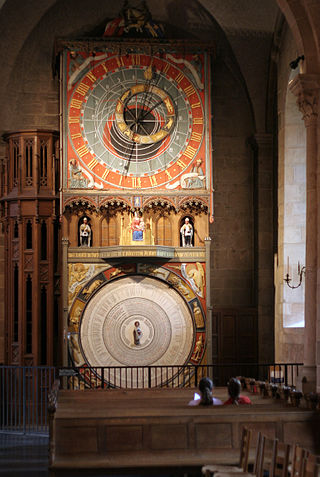
Swedish is a North Germanic language spoken predominantly in Sweden and in parts of Finland. It has at least 10 million native speakers, the fourth most spoken Germanic language and the first among any other of its type in the Nordic countries overall.

Christopher Polhammar better known as Christopher Polhem, which he took after his ennoblement in 1716, was a Swedish scientist, inventor and industrialist. He made significant contributions to the economic and industrial development of Sweden, particularly mining. He was ennobled by King Charles XII of Sweden for his contributions to Swedish technological development.

Sveriges Television AB, shortened to SVT, is the Swedish national public television broadcaster, funded by a public service tax on personal income set by the Riksdag. Prior to 2019, SVT was funded by a television licence fee payable by all owners of television sets. The Swedish public broadcasting system is largely modelled after the system used in the United Kingdom, and Sveriges Television shares many traits with its British counterpart, the BBC.

Lysekil is a locality and the seat of Lysekil Municipality in Västra Götaland County, Sweden. It had about 7,600 inhabitants in 2018. Situated on the south tip of Stångenäs peninsula at the mouth of Gullmarn fjord, it has two nature reserves.

Mora is a locality and the seat of Mora Municipality in Dalarna County, Sweden, with 10,896 inhabitants in 2010.
The 1905 season in Swedish football, starting January 1905 and ending December 1905:
The 1906 season in Swedish football, starting January 1906 and ending December 1906:

Johan Lindquist of Stockholm was an important 18th-century Swedish clock and watch maker. He was a pupil of Julien Le Roy in Paris in, perhaps, the 1740s, and in the late 1750s was appointed clock-maker to King Adolf Frederick of Sweden. He died on 4 June 1779. He numbered all his pieces, and was at approximately no. 620 by the time of his death.

Ljungby is the central locality of Ljungby Municipality, Kronoberg County, Sweden, with 15,785 inhabitants in 2015.

Södra Ängby is a residential area blending functionalism with garden city ideals, located in western Stockholm, Sweden, forming part of the Bromma borough.

Lund astronomical clock, occasionally and at least since the 16th century referred to as Horologium mirabile Lundense, is a 15th-century astronomical clock in Lund Cathedral. Mentioned in written sources for the first time in 1442, it was probably made and installed sometime around 1423–1425, possibly by Nikolaus Lilienfeld. It is part of a group of related medieval astronomical clocks found in the area around the south Baltic Sea. In 1837 the clock was dismantled. Between 1909 and 1923, it was restored by the Danish clockmaker Julius Bertram-Larsen and the Swedish architect responsible for the upkeep of the cathedral, Theodor Wåhlin. From the old clock, the face of the clock as well as the mechanism, which was largely replaced during the 18th century, was salvaged and re-used. The casing, most parts of the calendar which occupies the lower part, and the middle section were made anew.
The State Herald, between 1953 and 1981 called the Director of the Heraldic Section of the National [Swedish] Record Office is an officer of the National Archives of Sweden who is responsible for matters related to heraldry. Until 1953 the Riksheraldiker was the head of his own state agency, the National Heraldry Office (Riksheraldikerämbetet).

Katthammarsvik is a harbour settlement in Östergarn socken on the island of Gotland, Sweden.
As of 2005, it was in statistical terms defined as a småort and has formerly, very briefly, held the status of a tätort (locality).

The Central Swedish lowland is a large region of low relief and altitude in Sweden spanning from the Swedish West Coast at Bohuslän to Stockholm archipelago and Roslagen at the Baltic Sea. The Central Swedish lowland forms a broad east-west trending belt north of the South Swedish highlands and south of the Norrland terrain. Traditionally the heartland of Sweden due to its large population and agricultural resources the region benefits additionally from the proximity of hydropower, forest and mineral resources. The lowland is also at a good position for trade with the Baltic region. These advantages are reflected in the location of Sweden's capital, Stockholm, at the eastern end of the lowlands. Most of Sweden's manufacturing industries lies in this region.

Björkborn Manor is a manor house and the very last residence of Alfred Nobel in Sweden. The manor is located in Karlskoga Municipality, Örebro County, Sweden. The current-standing white-colored manor house was built in the 1810s, but the history of the property is older.

Knut Gunnar Bjurner was a senior Swedish Navy officer. Bjurner commanded three different coastal defence ships, headed Karlskrona Naval Yard (1931–1936) and commanded the Winter Squadron (1933–1934) as well as the South Coast Naval District (1936–1938). Bjurner is mostly known for his work within the Royal Swedish Naval Materiel Administration, which he headed from 1938 to 1943.
The Ministry of Commerce and Industry was a ministry in Sweden, established in 1920 when certain matters were taken over from the Ministry of Finance. The ministry was headed by the minister of commerce and industry. The ministry ceased to exist in 1982 and matters were transferred to the Ministry for Foreign Affairs.

The Minister of Supply was a member of the government of Sweden. The minister of supply was the head of the Ministry of Supply from 1939 to 1950 which handled matters relating to the national economy.
















